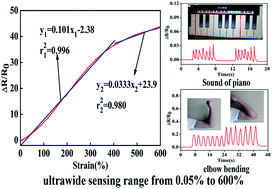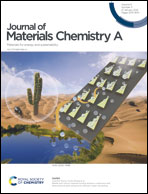A highly stretchable strain sensor with both an ultralow detection limit and an ultrawide sensing range†
Abstract
Stretchable strain sensors have promising applications in many fields, including soft robotic skin, health monitoring, wearable electronics, and so on. Among the various properties of stretchable strain sensors, the low detection limit and wide sensing range are the two most critical properties that determine their practical application in the above fields. However, it is still a great challenge to achieve both an ultralow detection limit and ultrawide sensing range at the same time, and there often needs to be a tradeoff between them. Herein, we propose a simple route to design a stretchable strain sensor with both an ultralow detection limit and an ultrawide sensing range by the combination of the electrospinning technique and ultrasonication anchoring technique. Specifically, thermoplastic polyurethane (TPU) is fabricated into a highly stretchable porous film and carbon nanotubes (CNTs) are anchored onto the surface of TPU nanofibers assisted by ultrasonication, and then assembled with two Cu electrodes to fabricate the strain sensor. Attributed to the multiscale evolution of the conductive network under stretching, the designed strain sensor exhibits many outstanding merits, such as an ultra-low detection limit (0.05%), an ultrawide sensing range from 0.05% to 600%, a fast response time of 75 ms, and excellent durability. Because of these outstanding merits, the TPU@CNT strain sensor can detect both the subtle strain change caused by the sound of a piano and the large strain change caused by the large-scale motions of joints. Moreover, it is found that TPU@CNT sensor responds to temperature and humidity, which has great potential in temperature sensors and humidity sensors.



 Please wait while we load your content...
Please wait while we load your content...